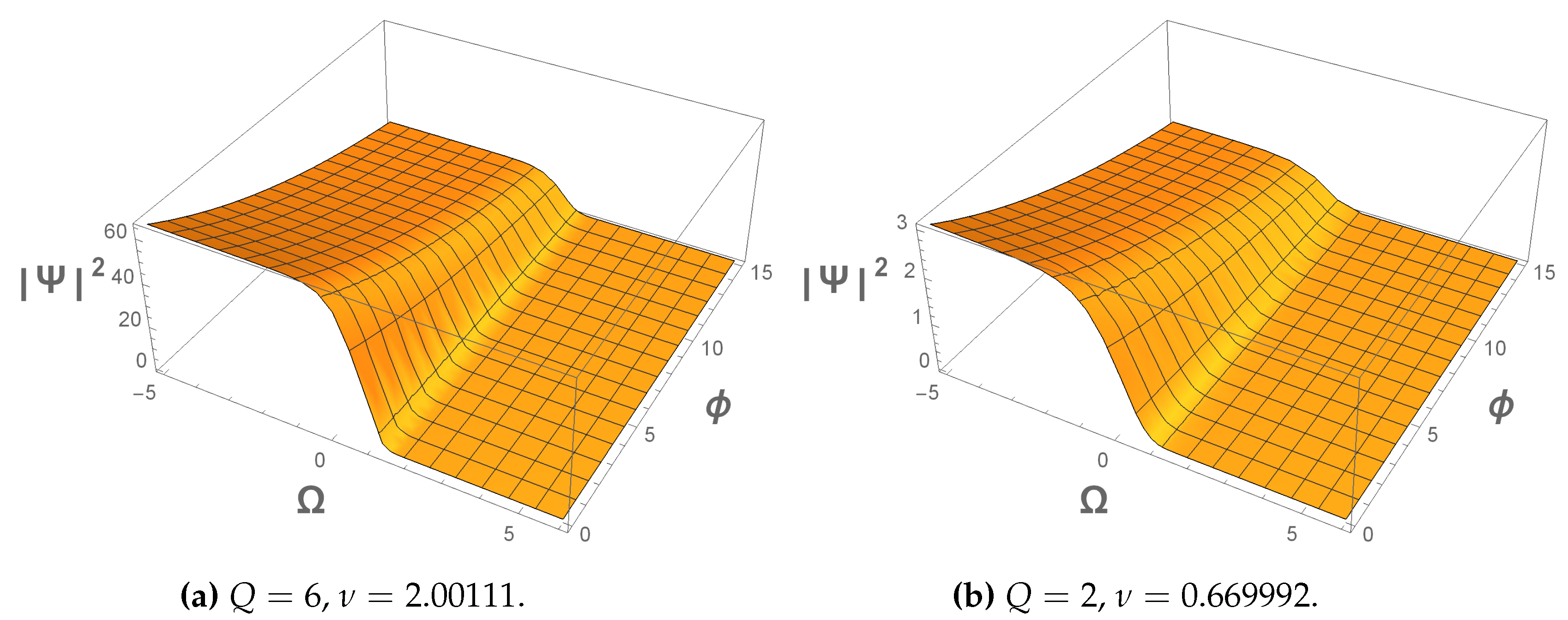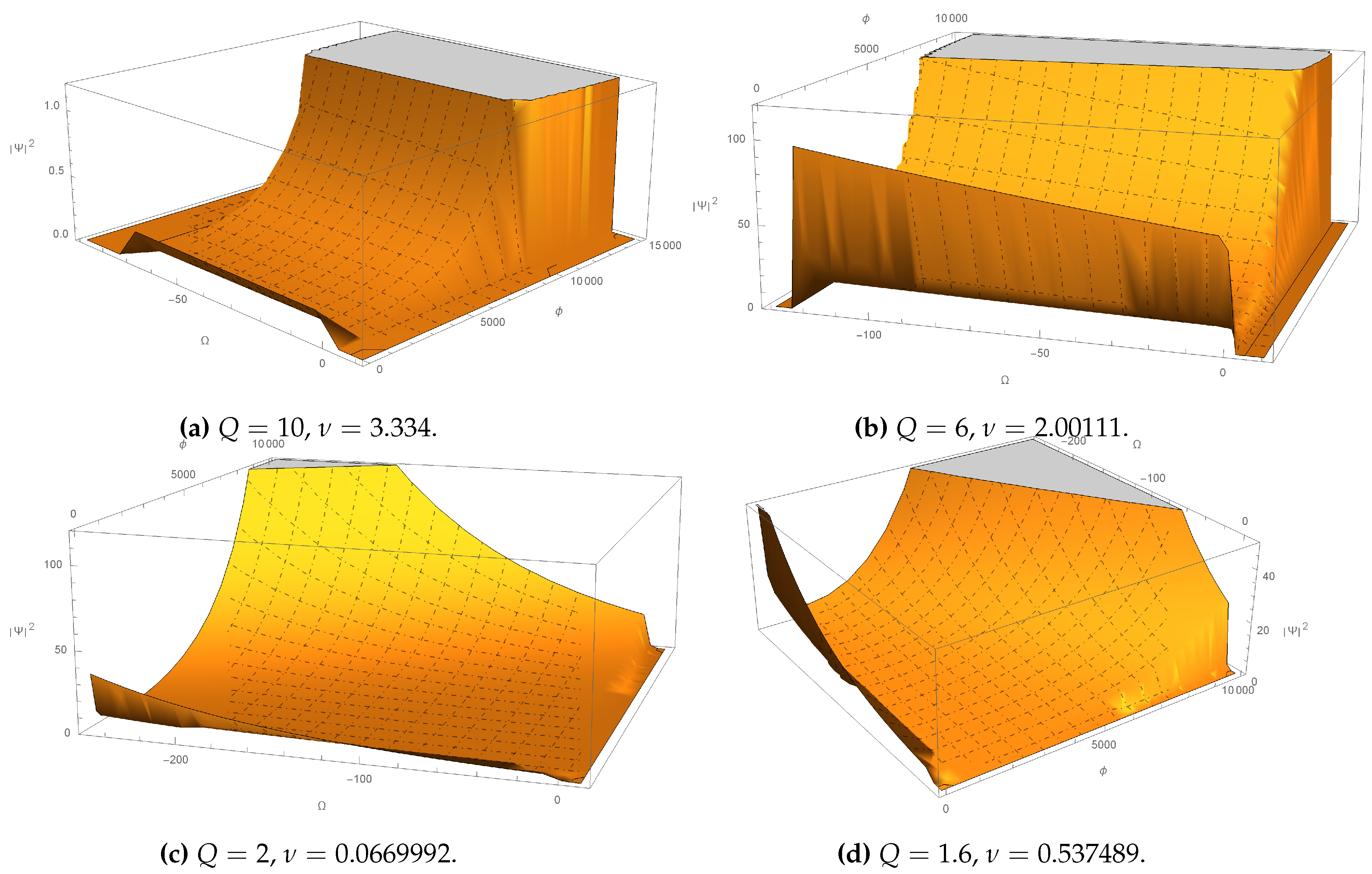Submitted:
15 September 2023
Posted:
19 September 2023
You are already at the latest version
Abstract
Keywords:
1. Introduction
2. Brief review on fractional calculus and K-essence theory
2.1. Brief review on fractional calculus
2.2. K-essence fractional in the Bianchi I scenario.
3. Lagrange and Hamilton formalism
3.1. Exact solution in the gauge .

3.2. Exact solution without gauge N in the time
3.3. Case for
3.3.1. Dust scenario,
4. Quantum Regime

4.1. Solution to FDE associated with the different state evolutions

5. Conclusions
- Using the K-essence formalism in a general way, applied to anisotropic Bianchi type I cosmological model, we found the Hamiltonian density in the scalar field momenta raised to power with non-integers, which produces in the quantum scheme a fractional differential equation in a natural way. We include the factor ordering problem in both variables and its momenta , with the order , where , and it was solved in a general way, we include two particular scenarios of our Universe.
- We found the solution in the classical scheme employing two gauge, , for two forms of the function in the time t; however, when we let the Lagrange multiplier N, we need to employ a transformed time for solving the classical equation, and only in the dust era, we recover the gauge time .
- In the quantum regime, when we include the factor ordering problem, the fractional differential equation in the scalar field appears with variable coefficients, and it was necessary to use the fractional series expansion to solve it in a general way.
- In one of our analysis presented on the probability density, we consider the values of the scalar field as significant in the quantum regime, appearing in various scenarios in the behaviour of the universe; mainly in those where the universe has a huge behaviour, for example, in the actual epoch, where the scalar field appears as a background, the quantum regime appears with big values, but it presents a moderate development in other scenarios with different ordering parameters Q and s.
Acknowledgments
References
- I. Podlubny, Fractional differential Equations (New York: Academic, 1999).
- V. Uchaikin. Fractional Derivatives for Physicists and Engineers, Springer, 2013.
- Herrmann R. Fractional Calculus: An Introduction For Physicists. World Scientific Publishing Co. Pte. Ltd. (2011).
- Caputo, M.; Mainarde. F.A. A new dissipation model based on memory mechanism. Pure Appl. Geophys. 1971, 91, 134-137.
- Wyss, W. Fractional diffusion equation. J. Math. Phys. 1986, 27, 2782–2785. [Google Scholar] [CrossRef]
- Westerlund, S. Capacitor theory. IEEE Trans. Dielectr. Electr. Insul. 1994, 1, 826–839. [Google Scholar] [CrossRef]
- H.C Rosu, A.L. H.C Rosu, A.L. Madueño and J. Socorro, J. Phys. A: Math. Gen. 36 1087-1093, (2003), Transform of Riccati equation of constant coefficients through fractional procedureand J. Socorro, J. Phys. A: Math. Gen. [CrossRef]
- Magin, R.L. Fractional Calculus in Bioengineering. 2006, Begell House Publisher: Rodding, Denmarc.
- Tarasov, V.E. Fractional Dynamics: Applications of Fractional Calculus to Dynamics of Particles, Fields and Media. Springer: Berlin/Heidelberg, Germany, 2010.
- Duarte Ortigueira, M.; Martynyuk, V,; Kosenkov, V.; Batista G.A,; A new look at the capacitor theory. Fractal Fract. 2023, 7, 86.
- Laskin, N. Fractional quantum mechnics. World Scientific Publishing Co. Pte. Ltd. (2018).
- P.V. Moniz, and S. Jalalzadeh, Mathematics 8 (3), 313 (2020), From Fractional Quantum Mechanics to Quantum Cosmology: An Overture.
- S. Jalalzadeh, F Rodrigues da Silva and P.V Moniz, The European Physical Journal C 81 (7), 632 (2021), Prospecting black hole thermodynamics with fractional quantum mechanics.
- Shahram Jalalzadeh, and Paulo Vargas Moniz, book: Challenging Routes in Quantum Cosmology, World Scientific Publiching Company (2023).
- Duarte Valério, M.D. Ortigueira and António M. Lopes, How Many Fractional Derivatives Are There? Mathematics 10, 737 (2022). [CrossRef]
- Ortigueira, M.D., A New Look at the Initial Condition Problem, Mathematics 10, 1771 (2022). [CrossRef]
- M.D. Ortigueira and Gary W. Bohannan, Fractional Scale Calculus: Hadamard vs.Liouville, Fractal Fract. 7 296 (2023). [CrossRef]
- M.D. Ortigueira and Gabriel Bengochea, A Simple Solution for the General Fractional Ambartsumian Equation, Appl. Sci. 13 871 (2023). [CrossRef]
- Godínez, F.A., Rosales, J.J., Esparza-Posadas, M.F. Newton’s Law of Cooling with Caputo Derivative: Consistent Dimensionality to Compare with Experiments. Fractals, Vol. 30, No. 9 (2022) 2250187. [CrossRef]
- Rosales-García, J., Andrade-Lucio, J.A., Shulika, O. Conformable derivative applied to experimental Newton law of cooling. Revista Mexicana de Física 66 (2) 224-227, 2020. [CrossRef]
- El-Nabulsi Ahmad Rami. Fractional Unstable Euclidean Universe, EJTP, 8, 1-11, (2005).
- R.A. El-Nabulsi, Int. J. Theor. Phys. 51, 3978-3992, (2012), Gravitons in fractional action cosmology. [CrossRef]
- R.A. El-Nabulsi, Indian J. Phys. 87, 835-840 (2013). Non-minimal coupling in fractional action cosmology. [CrossRef]
- E.N.A. Rami, Eur. Phys. J. Plus 130, 102 (2015), Fractional action oscillating phantom cosmology with conformal coupling. [CrossRef]
- R.A. El-Nabulsi, Int. J. Theor. Phys. 55, 625-635, (2016), A Cosmology Governed by a Fractional Differential Equation and the Generalized Kilbas-Saigo-Mittag-Leffler Function. [CrossRef]
- R.A. El-Nabulsi, Rev. Mex. Fis. 62, 240 (2016), Implications of the Ornstein-Uhlenbeck-like fractional differential equation in cosmology.
- R.A. El-Nabulsi, Int. J. Theor. Phys. 56, 1159-1182 (2017), Fractional Action Cosmology with Variable Order Parameter. [CrossRef]
- R.A. El-Nabulsi, Can. J. Phys. 95, 605-609 (2017), ıWormholes in fractional action cosmology. [CrossRef]
- S.M.M Rasouli, S. Jalalzadeh, and P.V. Moniz, Modern Physics Letters A 36 (14), 2140005 (2021), Broadening quantum cosmology with a fractional whirl.
- S. Jalalzadeh, E.W Oliveira Costa and P.V. Moniz, Physical Review D 105 (12), L121901 (2022), de Sitter fractional quantum cosmology.
- S.M.M. Rasouli, E.W Oliveira Costa, P.V. Moniz and S. Jalalzadeh, Fractal and Fractional 6 (11), 655 (2022), Inflation and fractional quantum cosmology.
- El-Nabulsi Ahmad Rami. Cosmology with Fractional Action Principle, Romanian Reports in Physics, 39(3), 763-771. (2007).
- Miguel A. García-Aspeitia, Guillermo Fernández Anaya, A. Hernández Almada, Genly León, Juan Magaña. Cosmology under the fractional calculus approach. Monthly Notices, 517(4), 4813-4826, (2022). [CrossRef]
- Genly Leon, Miguel A. García-Aspeitia, Guillermo Fernández-Anaya, Alberto Hernández-Almada, Juan Magaña., Esteban González. Cosmology under the fractional calculus approach: a possible H0 tension resolution. arXiv:2304.14465v1 [gr-qc], 27 april 2023. [CrossRef]
- Rami Ahmad El-Nabulsi. Gravitons in fractional action cosmology. Int. J. Phys, 51; 3978-3992, (2012).
- Socorro J., Luis O. Pimentel and Abraham Espinoza García, Advances in High Energy Phys. 805164 (2014), Classical Bianchi type I cosmology in K-essence theory. [CrossRef]
- Socorro J., Juan Rosales J. Quantum fraccionary cosmology: K-essence theory. Universe, (2023), 9, 185. [CrossRef]
- El-Ajou, A.; Arqub, O.A.; Zhour, Z.A.; Momani, S. New Results on Fractional Power Series: Theories and Applications. Entropy 2013, 15, 5305–5323. [Google Scholar] [CrossRef]
- Rida, S. Z. and Arafa, A. A. M. New Method for Solving Linear Fractional Differential Equations. International Journal of Differential Equations, Volume 2011, Article ID 814132, 8 pages. [CrossRef]
- Tarasov, V.E. No violation of the Leibniz rule. No fractional derivative. Communications in Nonlinear Science and Numerical Simulation 18(11), 2945-2948, (2013). [CrossRef]
- Ortigueira M. D., Tenreiro Machado J.A., What is a fractional derivative?. Journal of computational Physics, 293, 4-13, (2015). [CrossRef]
- Sales Teodoro G., Tenreiro Machado, J.A., Capelas de Oliveira E. A review of definitions of fractional derivatives and other operators. Journal of computational Physics, 388, 195-208, (2019). [CrossRef]
- Trifce Sandev, Alexander Iomin. Special Functions of Fractional Calculus: Applications to Diffusion and Random Search Processes. World Scientific Publishing Co. Pte. Ltd. (2023).
- Erdelyi, A; Magnus, W.; Oberthettinger, F.; Tricomi, F.G. Higher Transcendental Functions. McGraw-Hill: New York, NY, USA, 1955.
- Haubold, H.J.; Mathai, A.M.; Saxena, R.K. Mittag-Leffler functions and their applications. J. Appl. Math. 2011, 298628. [CrossRef]
- Abraham Espinoza García, J. Socorro and Luis O. Pimentel, Int. J. of Theor. Phys. 53 (9), 3066-3077 (2014), Quantum Bianchi type IX cosmology in K-essence theory. [CrossRef]
- Roland de Putter and Eric V. Linder, Astropart. Phys. 28, 263 (2007). Kinetic k-essence and Quintessence. [arXiv:0705.0400]. arXiv:0705.0400].
- Chiba T, Dutta S and Scherrer R.J. Phys. Rev. D 80, 043517 (2009). Slow-roll k-essence, [arXiv:0906.0628]. arXiv:0906.0628].
- Bose N. and Majumdar A.S. Phys. Rev. D 79, 103517 (2009). A k-essence model of inflation, dark matter and dark energy, [arXiv:0812.4131]. arXiv:0812.4131].
- Arroja F. and Sasaki M. Phys. Rev. D 81, 107301 (2010).
- García L.A, Tejeiro J.M and Castañeda L. K-essence scalar field as dynamical dark energy, [arXiv:1210.5259]. arXiv:1210.5259].
- Bilic N, Tupper G. and Viollier R. Phys.Lett. B 535, 17 (2002).
- Bento M, Bertolami O and Sen A. Phys.Rev.D 66, 043507(2002). Dynamics of dark energy, [arXiv:hep-th 0603057].
- Andrei C. Polyanin and Valentin F. Zaitsev, Handbook of Exact solutions for ordinary differential equations, Second edition, Chapman Hall/CRC. (2003).
| State of evolution | |||
|---|---|---|---|
| 1 | 1 | X | Stiff matter |
| 2 | Radiation | ||
| , | Dust like | ||
| 0 | 1, | Inflation | |
| -1 | Inflation like | ||
| Inflation like |
| Fractionary equation | |||
|---|---|---|---|
| 1 | 1 | 1 | |
| 2 | |||
| 0 | 0 | ||
| -1 | |||
Disclaimer/Publisher’s Note: The statements, opinions and data contained in all publications are solely those of the individual author(s) and contributor(s) and not of MDPI and/or the editor(s). MDPI and/or the editor(s) disclaim responsibility for any injury to people or property resulting from any ideas, methods, instructions or products referred to in the content. |
© 2023 by the authors. Licensee MDPI, Basel, Switzerland. This article is an open access article distributed under the terms and conditions of the Creative Commons Attribution (CC BY) license (http://creativecommons.org/licenses/by/4.0/).





